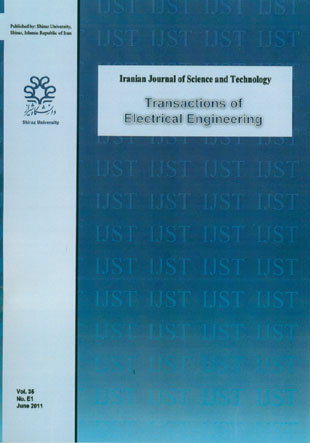فهرست مطالب

Iranian Journal of science and Technology (B: Engineering)
Volume:35 Issue: 3, May 2011
- Transactions of Electrical Engineering
- تاریخ انتشار: 1390/05/01
- تعداد عناوین: 5
-
-
Pages 1-11The effects of the oxygen vacancies on the microscopic potential distribution and macroscopic potential averaged over one period around the defect for silicon dioxide have been investigated via first-principles calculations. The results demonstrate that such an effect is limited to the dimensions of one cell. Detailed analysis of the planar macroscopic average potential shows that the conduction band alignment caused by the defect and its effects on the tunneling currents have been calculated. The calculations demonstrate that the relative increase in the electron direct tunneling current caused by the oxygen vacancy depends on the position of oxygen vacancy. It is also shown that the increase in the direct tunneling current caused by the oxygen vacancy exponentially decreases with increasing oxide thickness, whereas its relative increase changes little.
-
Pages 13-24Dissolved Gas Analysis (DGA) is the most reliable technique to identify the incipient faults in power transformers. There are several DGA techniques in use such as Doernenburg, Rogers, IEC, etc. On the other side there is an increasing tendency to combine data from multiple sources and models to achieve more reliable results than individuals. This investigation proposes two fusion approaches consisting of fusion architectures and respective combination methods to combine DGA techniques and the gas ratios utilized in these techniques. The proposed approaches in this article apply a modified flexible neuro-fuzzy and a gating network as combination methods. Various gas concentration data were used for training and validating the models. Results showed that the proposed approaches have more advantages compared to the conventional DGA techniques. Finally, the importance degree of each gas-ratio to detect each fault was investigated.
-
Pages 25-43In this paper a new structure for the MLF (Multi Loop Feedback) Gm-C group of filters is presented, granting the advantages of both current-mode and fully balanced topologies to the conventional structure of the group. The ability of the structure to perform even more transfer functions (Low pass and Band Pass) than other members of the group is proved. Methods of enabling the proposed structure to perform other popular transfer functions are also presented. The favorite feature of systematical generation of the structure facilitates its arrangement for any order. For practical comparison, a Butterworth 4th–order LP filter with a cut-off frequency of 10MHz is designed in three different structures viz; the proposed one, the single-ended current mode, and fully balanced voltage mode. Simulation results show that the PSRR+,PSRR-,CMRR, Noise, THD, DR, consumed power (P) and Figure of Merit (FOM) of the new structure compared to its voltage mode counterpart are improved at least by factors of 36643, 59841, 4.75, 76, 2, 2.45, 1.17 and 509500, respectively.Compared to single ended current-mode type they are improved by factors of 40, 73, not defined, 1.3, 7.8, 150, 0.68 and 1763000,respectively. Although the above mentioned comparison, due to both the similarity of the used technology and the completeness of the results, is the most equitable one for the most definite conclusion, to further widen the extent of the comparison, the proposed structure is also compared with some other works yet assumed as its closet counterparts. This latter comparison also proves the certain superiorities of the proposed structure such that its FOM is from 8500 to 4512740 times larger than those of others. Closer tracking of the input signal at pass-band and more attenuation at stop-band are also achieved by this structure. These results strongly support the theoretical suggestions. Most favorably the much higher PSRR of the new structure makes it an extremely suitable choice for Mix-Mode (System-On- a Chip, SOC/SOI) applications where power supplies (and analog blocks) suffer severely from digital noise.
-
Pages 45-61One of the key challenges in next generation access networks based on Ethernet Passive Optical Network (EPON) technology is Dynamic Bandwidth Allocation (DBA) process. In this paper we have proposed ‘Parnian’, a two-stage nested-auction for dynamic bandwidth allocation management in Ethernet Passive Optical Networks. In the proposed ‘Parnian’ method, by running nested auction, based on EPON architecture, the Optical Network Units locally optimize the user's bandwidth requests by first stage auction and then the Optical Line Terminal runs the second stage auction for allocating the requested bandwidths dynamically and effectively. Simulation results show that ‘Parnian’, in comparison with the Fair Sharing with Dual Service Level Agreement (FSD-SLA) and limited service Interleaved polling with adaptive cycle time (IPACT) experiences more delay, but regarding other quality of service parameters such as execution time, packet loss ratio, line utilization, and throughput, it has a better performance.
-
Pages 63-74This paper presents a new technique based on model reference adaptive system (MRAS) observer for sensorless speed control of Two-Phase Induction Motor (TPIM). The MRAS identification is performed by means of comparison of stator fluxes obtained from both stator and rotor equations with stator voltage and current measurements. Simulation and experimental results for a 1.1 kW TPIM set-up are presented and analysed using a dSpace system with a DS1104 controller board based on digital signal processor (DSP) TMS320F240. Simulation and experimental results at nominal, low and zero speeds confirm the effectiveness of the proposed sensorless speed controlled TPIM drive.

